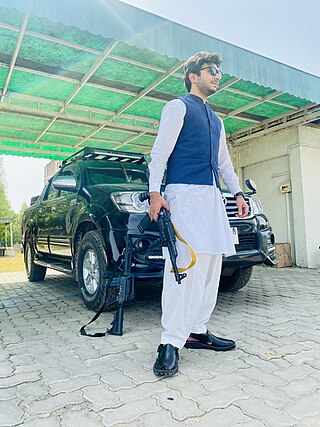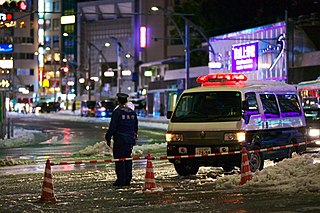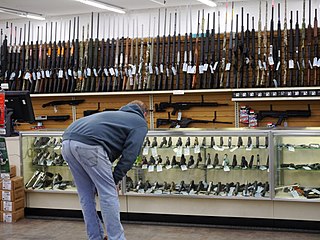Gun laws and policies, collectively referred to as firearms regulation or gun control, regulate the manufacture, sale, transfer, possession, modification, and use of small arms by civilians. Laws of some countries may afford civilians a right to keep and bear arms, and have more liberal gun laws than neighboring jurisdictions. Countries that regulate access to firearms will typically restrict access to certain categories of firearms and then restrict the categories of persons who may be granted a license for access to such firearms. There may be separate licenses for hunting, sport shooting, self-defense, collecting, and concealed carry, with different sets of requirements, permissions, and responsibilities.

Arms trafficking or gunrunning is the illicit trade of contraband small arms, explosives, and ammunition, which constitutes part of a broad range of illegal activities often associated with transnational criminal organizations. The illegal trade of small arms, unlike other organized crime commodities, is more closely associated with exercising power in communities instead of achieving economic gain. Scholars estimate illegal arms transactions amount to over US$1 billion annually.

Gun control, or firearms regulation, is the set of laws or policies that regulate the manufacture, sale, transfer, possession, modification, or use of firearms by civilians.
The small arms trade is the markets of both authorized and illicit small arms and light weapons (SALW), as well as their parts, accessories, and ammunition.

Gun laws in Pakistan allow for the ownership of firearms in the country by the general population. Pakistan is one of the biggest open firearms markets in the world, and is in the modern era also known for its indigenous gunsmith tradition. The country is famous for producing clones of almost every notable weapon of the world. Although firearms are widely owned, heavy weaponry is permitted only in tribal areas within the province of Khyber Pakhtunkhwa. This includes the circulation of rocket-propelled grenades, short, medium, and long-range rockets, anti-aircraft guns, mortars and other types of firearms.

Gun culture in the United States encompasses the behaviors, attitudes, and beliefs about firearms and their use by private citizens. Gun ownership in the United States is legally protected by the Second Amendment to the United States Constitution. Firearms are used for self-defense, hunting, and recreation.

Law enforcement in Japan is provided mainly by prefectural police under the oversight of the National Police Agency. The National Police Agency is administered by the National Public Safety Commission, ensuring that Japan's police are an apolitical body and free of direct central government executive control. They are checked by an independent judiciary and monitored by a free and active press.

Small arms and light weapons (SALW) refers in arms control protocols to two main classes of man-portable weapons.
The gun laws of New Zealand are contained in the Arms Act 1983 statute, which includes multiple amendments including those that were passed subsequent to the 1990 Aramoana massacre and the 2019 Christchurch mosque shootings.

In 2018, the Small Arms Survey reported that there are over one billion small arms distributed globally, of which 857 million are in civilian hands. The survey stated that American civilians account for an estimated 393 million of the worldwide total of civilian held firearms, or about 120.5 firearms for every 100 American residents.
The Small Arms Survey (SAS) is an independent research project located at the Graduate Institute of International and Development Studies in Geneva, Switzerland. It provides information on all aspects of small arms and armed violence, as a resource for governments, policy-makers, researchers, and activists, as well as research on small arms issues.
In Honduras, the commerce, ownership, possession and use of firearms is regulated. Escalation in crime and the use of firearms in the commission of crimes and homicides has brought political and public discourse to consider regulation of arms.
Firearms in Thailand refers to the number and types of firearms in the country in civilian (unofficial) hands and the laws and societal norms that govern their possession and use.
Ukrainian law allows firearm ownership on may-issue basis. With approximately 10 civilian firearms per 100 people, Ukraine is the 88th most armed country in the world per capita, and 22nd overall.
Polish law allows modern firearms ownership on a general shall-issue basis under police-issued permit for people who provide an important reason. Hunting, sport shooting, training and collecting are the most popular reasons and require membership in suitable organizations. Self-defense permits for civilians are chief exceptions to the rule, where a may-issue based permit is required. Antique black powder firearms or their replicas and most air guns are available without a permit. Firearm owners are subject to mental health and domestic violence confiscation laws resembling U.S red flag laws.
Maltese law allows possession of various types of firearms on shall-issue basis. With approximately 28 civilian firearms per 100 people, Malta is the 18th most armed country in the world.
Gun laws in North Macedonia allow firearm ownership on shall-issue basis for hunters and collectors and may-issue for self-defense purposes. With approximately 30 civilian firearms per 100 people, North Macedonia is the 15th most armed country in the world.
Uruguayan law allows firearm possession on shall-issue basis. With approximately 35 civilian firearms per 100 people, Uruguay is the eighth most armed country in the world and most armed in Latin America.

This is a list of countries by the estimated percent of households with guns. It is further broken down by the estimated percent of households with handguns. Also, by the estimated percent of adults living in armed households. The data is from GunPolicy.org which is hosted by the Sydney Medical School, at the University of Sydney in Australia. GunPolicy.org consolidates this data from various sources. To avoid problems with vetting the data for hundreds of countries from hundreds of sources, the table below only uses data compiled by GunPolicy.org.








